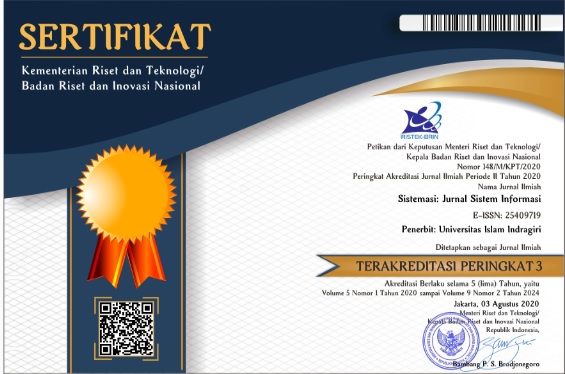Market Basket Analysis for Determine Goods Layout Using FP-Growth Algorithm
Abstract
Full Text:
PDFReferences
N. S. Faizaty, B. W. Septiani, A. H. Zahran, Fitriyani, and A. De Alvaroziq, “Perancangan Ulang Tata Letak Pada Toko Ritel Mitra Hotel,” Jurnal Ilmiah Ekonomi dan Manajemen, vol. 2, no. 6, pp. 303–310, 2024, doi: 10.61722/jiem.v2i6.1440.
U. Khasanah, Y. Kusumawaty, and Eliza, “The Influence of Marketing Mix on Consumer Behavior on Vegetable Purchases at Jumbo Mart Delima Modern Market Inhandsome Sub-District of Pekanbaru City,” Jurnal Ilmiah Sosio Ekonomika Bisnis, vol. 26, no. 01, pp. 33–39, 2023.
S. Yakub, A. Fitri Boy, I. Mariami, and B. Widjanarko, “Penerapan Data Mining Pengaturan Pola Tata Letak Barang Pada Berkah Swalayan Untuk Strategi Penjualan Menggunakan Algoritma Apriori,” Jurnal Teknologi Sistem Informasi dan Sistem Komputer TGD, vol. 69, no. 1, pp. 69–75, 2019, doi: 10.53513/jsk.v2i1.91.
E. Munanda and S. Monalisa, “Penerapan Algoritma Fp-Growth Pada Data Transaksi Penjualan Untuk Penentuan Tataletak Barang,” Jurnal Ilmiah Rekayasa dan Manajemen Sistem Informasi, vol. 7, no. 2, pp. 173–184, 2021.
F. Mardianti and R. Fauzi, “Algoritma Apriori Dalam Menentukan Pola Konsumen Terhadap Tata Letak Barang,” Jurnal Comasie, vol. 6, no. 2, pp. 40–51, 2021.
M. Y. Ardianto, S. Adinugroho, and Indriati, “Penentuan Tata Letak Produk menggunakan Algoritma FP-Growth pada Toko ATK,” Jurnal Pengembangan Teknologi Informasi dan Ilmu Komputer, vol. 5, no. 9, pp. 3826–3832, 2021, [Online]. Available: http://j-ptiik.ub.ac.id.
I. Juwita and I. Ali, “Penerapan Pola Penjualan Dengan Menggunakan Metode Algoritma Asosiasi Fp-Growth Bertujuan Untuk Meningkatkan Penjualan Kopi Di Point Coffee,” JATI (Jurnal Mahasiswa Teknik Informatika), vol. 8, no. 2, pp. 1600–1607, 2024, doi: 10.36040/jati.v8i2.9025.
O. Pratama and J. Haerul Jaman, “Penerapan Data Mining Menggunakan Algoritma Apriori Untuk Mengetahui Kebiasaan Konsumen Dan Prediksi Stok Produk,” JATI (Jurnal Mahasiswa Teknik Informatika), vol. 7, no. 3, pp. 1837–1844, 2023, doi: 10.36040/jati.v7i3.7016.
A. Anggrawan, M. Mayadi, and C. Satria, “Menentukan Akurasi Tata Letak Barang dengan Menggunakan Algoritma Apriori dan Algoritma FP-Growth,” MATRIK : Jurnal Manajemen, Teknik Informatika dan Rekayasa Komputer, vol. 21, no. 1, pp. 125–138, 2021, doi: 10.30812/matrik.v21i1.1260.
S. Herdyansyah, E. H. Hermaliani, L. Kurniawati, and S. R. Sri Rahayu, “Analisa Metode Association Rule Menggunakan Algoritma Fp-Growth Terhadap Data Penjualan (Study Kasus Toko Berkah),” Jurnal Khatulistiwa Informatika, vol. 8, no. 2, pp. 127–133, 2020, doi: 10.31294/jki.v8i2.9277.
D. Wicaksono, M. I. Jambak, and D. M. Saputra, “The Comparison of Apriori Algorithm with Preprocessing and FP-Growth Algorithm for Finding Frequent Data Pattern in Association Rule,” in Sriwijaya International Conference on Information Technology and Its Applications (SICONIAN), 2020, vol. 172, pp. 315–319, doi: 10.2991/aisr.k.200424.047.
A. Padillah, H. Satria Tambunan, R. A. Nasution, and G. Artikel, “Penerapan Algoritma FP-Growth dalam Menganalisa Pola dan Tata Letak Bahan Makanan,” JOMLAI: Journal of Machine Learning and Artificial Intelligence, vol. 1, no. 4, pp. 2828–9099, 2022, doi: 10.55123/jomlai.v1i4.1673.
P. Edastama, A. S. Bist, and A. Prambudi, “Implementation Of Data Mining On Glasses Sales Using The Apriori Algorithm,” International Journal of Cyber and IT Service Management, vol. 1, no. 2, pp. 159–172, 2021, doi: 10.34306/ijcitsm.v1i2.46.
J. Yang et al., “Brief introduction of medical database and data mining technology in big data era,” WiILEY, no. August 2019, pp. 1–13, 2020, doi: 10.1111/jebm.12373.
E.-H. A. Rady and A. S. Anwar, “Prediction of kidney disease stages using data mining algorithms,” Informatics in Medicine Unlocked, vol. 15, p. 100178, 2019, doi: 10.1016/j.imu.2019.100178.
R. Fauzi, A. W. Aranski, N. Nopriadi, and E. Hutabri, “Implementasi Data Mining Pada Penjualan Pakaian dengan Algoritma FP-Growth,” JURIKOM (Jurnal Riset Komputer), vol. 10, no. 2, p. 436, 2023, doi: 10.30865/jurikom.v10i2.5795.
K. N. Wijaya, “Analisa Pola Frekuensi Keranjang Belanja Dengan Dengan Perbandingan Algoritma Fp-Growth (Frequent Pattern Growth) dan Eclat pada minimarket,” JATISI (Jurnal Teknik Informatika dan Sistem Informasi), vol. 7, no. 2, pp. 364–373, 2020, doi: 10.35957/jatisi.v7i2.380.
A. Febiyanto, A. Faqih, R. Herdiyana, N. Dienwati Nuris, and R. Narasati, “Penerapan Algoritma Fp-Growth Untuk Menenntukan Pola Penjualan Produk Elektronik,” JATI (Jurnal Mahasiswa Teknik Informatika), vol. 7, no. 6, pp. 3907–3912, 2024, doi: 10.36040/jati.v7i6.8286.
A. K. Putra, R. Hamonangan, R. Herdiana, E. Tohidi, and U. Hayati, “Penerapan Algoritma FP Growth pada Penjualan Produk Distro Raden Madura,” MEANS (Media Informasi Analisa dan Sistem), vol. 7, no. 1, pp. 57–64, 2022, doi: 10.54367/means.v7i1.1858.
J. P. B. Saputra, S. A. Rahayu, and T. Hariguna, “Market Basket Analysis Using FP-Growth Algorithm to Design Marketing Strategy by Determining Consumer Purchasing Patterns,” Journal of Applied Data Sciences, vol. 4, no. 1, pp. 38–49, 2023, doi: 10.47738/jads.v4i1.83.
A. R. Riszky and M. Sadikin, “Data Mining Menggunakan Algoritma Apriori untuk Rekomendasi Produk bagi Pelanggan,” Jurnal Teknologi dan Sistem Komputer, vol. 7, no. 3, pp. 103–108, 2019, doi: 10.14710/jtsiskom.7.3.2019.103-108.
S. P. Pratama, “Analisis Data Mining Assosiasi FP-Growth Pada Penjualan Produk di Toko Ritel Agung,” Jurnal Tekinkom (Teknik Informasi dan Komputer, vol. 6, no. 1, pp. 63–71, 2023, doi: 10.37600/tekinkom.v6i1.744.
R. Lorentiana Wijayanti, R. Kurniawan, M. Mulyawan, R. Herdiana, and H. Susana, “Komparasi Algoritma Apriori Dan Fp-Growth Untuk Memberikan Strategi Diskon,” JATI (Jurnal Mahasiswa Teknik Informatika), vol. 8, no. 1, pp. 1096–1102, 2024, doi: 10.36040/jati.v8i1.8935.
DOI: https://doi.org/10.32520/stmsi.v13i4.4268
Article Metrics
Abstract view : 562 timesPDF - 165 times
Refbacks
- There are currently no refbacks.

This work is licensed under a Creative Commons Attribution-ShareAlike 4.0 International License.









